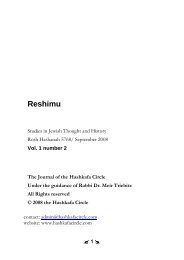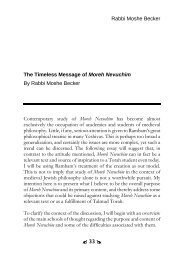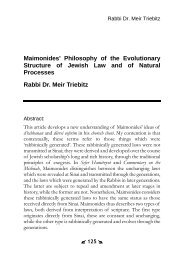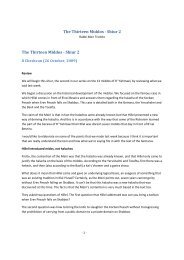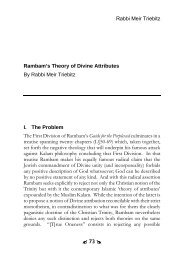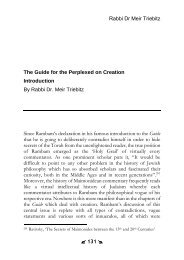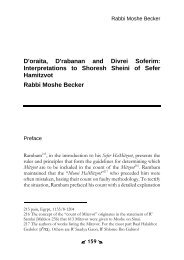Rabbi David Sedley 7 Introduction Baruch ... - Hashkafa Circle
Rabbi David Sedley 7 Introduction Baruch ... - Hashkafa Circle
Rabbi David Sedley 7 Introduction Baruch ... - Hashkafa Circle
You also want an ePaper? Increase the reach of your titles
YUMPU automatically turns print PDFs into web optimized ePapers that Google loves.
<strong>Rabbi</strong> <strong>David</strong> <strong>Sedley</strong><br />
<strong>Introduction</strong><br />
<strong>Baruch</strong> Hashem the first issue of Reshimu was very well received<br />
and we have had very positive feedback. Now we are excited to<br />
present the second issue.<br />
The name Reshimu is based on a kabbalistic idea that <strong>Rabbi</strong> Triebitz<br />
explained during his series of video shiurim on the Vilna Gaon’s<br />
Asarah Klalim. 1 After God ‘contracted’ Himself through the<br />
mechanism of tzimtzum there was an empty ‘space’ where God was<br />
not readily apparent. This ‘space’ is called the Reshimu and allows for<br />
a natural world which runs according to laws of nature, apparently<br />
without God’s intervention. God then came back into the world<br />
through the kav which allows for providence and miracles.<br />
We named this journal Reshimu because our goal is to present an<br />
approach to Jewish philosophy which allows for the co-existence of<br />
both the rational and miraculous. We have made our main focus the<br />
works of perhaps the most famous Jewish rationalist philosopher -<br />
Rambam – and his Moreh Nevuchim.<br />
In this issue we have also expanded our focus to different areas of<br />
Jewish philosophy and history. <strong>Rabbi</strong> Triebitz has written two articles<br />
1 Available from www.hashkafacircle.com/gaon<br />
7
<strong>Introduction</strong><br />
focusing on different periods of history, and giving each his own<br />
unique view. He shows how the history of Western thought since<br />
Descartes, which progresses in discrete paradigmatic steps, has been<br />
mirrored by similar paradigmatic changes in Jewish philosophy. He<br />
finds the common threads between the two apparently different<br />
approaches to the world. In his article on the emergence of the<br />
Mishna and Tosefta <strong>Rabbi</strong> Triebitz casts light on a little known<br />
subject, yet one which underlies almost all Jewish learning. He<br />
explains the change from scriptural exegesis to Talmud, which is a<br />
type of exegesis of mishna, the implications of that, and discusses the<br />
nature and function of Tosefta.<br />
<strong>Rabbi</strong> Becker shows the relevance of Moreh Nevuchim to our<br />
generation. The questions and issues which Rambam faced almost<br />
1000 years ago are, for the most part, still the questions and issues<br />
that face Jewish thinkers today.<br />
<strong>Rabbi</strong> Salber shows that the concept of creation ex-nihilo,in the context<br />
of the history of Jewish thought. Furthermore, there are many<br />
rabbinic statements which flatly contradict the concept of creation<br />
from nothing.<br />
My article examines the changing attitudes to aggada, and how it was<br />
used and understood by the Talmud, Gaonim and Rishnonim.<br />
Finally, in time for Rosh Hashanah, the anniversary of creation, we<br />
are very pleased to be able to include the first two chapters of <strong>Rabbi</strong><br />
Triebitz’s forthcoming commentary on Moreh Nevuchim. He has been<br />
giving shiur for the past half year on those chapters where Rambam<br />
explains creation. The shiurim have been available for viewing online<br />
at www.hashkafacircle.com/rambam. These shiurim are now being<br />
written up as a book, with a new translation of Moreh Nevuchim and a<br />
brand new commentary explaining the issues that Rambam is dealing<br />
with.<br />
8
<strong>Rabbi</strong> <strong>David</strong> <strong>Sedley</strong><br />
As always, we hope that you enjoy this journal. It is available either as<br />
a free pdf download from www.hashkafacircle.com/reshimu or for<br />
purchase as a paperback journal from www.lulu.com<br />
Please send any comments or feedback, or any articles for publication<br />
in future editions of Reshimu to hashkafacircle@gmail.com.<br />
With blessings for a healthy and happy New Year and ketiva ve-chatima<br />
tova<br />
<strong>David</strong> <strong>Sedley</strong><br />
Elul 5768, Yerushayalim.<br />
-------------------------<br />
A correction:<br />
Thank you to <strong>Rabbi</strong> Aryeh Bergman for pointing out that the<br />
statement in the name of the Netziv p’shuto shel mikreh on p. 141 of<br />
volume 1; number 1 of Reshimu is not accurate. The Netziv is<br />
referring to the derashot of Chazal.<br />
9



